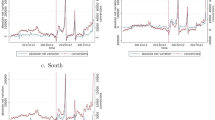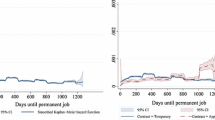Abstract
This paper investigates the effects of training apprentices on the productivity of Hungarian firms. In order to retrieve a causal estimate of the effects of apprenticeship training on firm performance, we apply a set of dynamic panel data estimation techniques. We create a unique administrative matched employer–employee panel dataset containing over 40,000 employers in Hungary over the period between 2003 and 2011 in the manufacturing, construction, wholesale and retail, and hotels and restaurants sector. Our results indicate that an increase in the share of apprentices (per full-time equivalent worker) decreases the productivity of Hungarian firms in all four sectors. Further, we observe that retention rates of apprentices are low and further slacken in the final years of observation.

Source: Authors own design based on CEDEFOP (2011)

Source: Compiled by the authors

Source: Compiled by the authors

Source: Compiled by the authors

Source: Compiled by the authors

Source: Compiled by the authors
Similar content being viewed by others
Notes
Finland (71.3%), Croatia (70.4%) and Austria (69.5%) capture the largest shares of students enrolled in VET, while Malta (12.7%), Cyprus (15.6%) and Hungary (23.2%) the lowest shares.
According to Mohrenweiser and Backes-Gellner (2010), in Germany, 18.5% of firms follow a substitution strategy, while 43.7% follow an investment strategy.
Hungarian legislation stipulates that apprentices have to work with special government-regulated contracts.
Retention rates of about 77% are mentioned for the German manufacturing sector. These rates can be compared with 72% for the trade and commercial sector and 61.5% for the crafts and construction sector (Mohrenweiser and Zwick 2009, p. 632, footnote 5).
It should be noted that the compulsory education age in Hungary changed in 2012 to 3 years (entrance age) and 16 years. However, this change happened after our examined time period of 2003–2011.
This figure excludes 64,984 students from post-secondary non-tertiary VET who are enrolled in SZKI.
These shares were relatively stable during our examined period (see CEDEFOP 2011, Fig. 4, page 31.).
In September 2010, ‘early VET programs’ (előrehozott szakiskolai képzés) were introduced, which offer 3 years of vocational training right after the completion of lower secondary education.
In 2011, about 60% of the 11th- and 12th-grade VET students participated in on-the-job training programs, while 40% of VET students participated in school-based workshops (based on KIR-STAT 2011, Table a05t24). Apparently, on-the-job training is more popular among VET students than school-based training.
For the former two options, firms cannot use the whole amount of their mandatory VET tax. They can use up to 70% of the total tax for offering direct support for secondary institutions and 35% for supporting tertiary institutions. Larger firms can use up to 33% and small and medium enterprises up to 60% of the total tax to train their own workers. Also the possibility of training own employees ended in 2012 because of a legislation change, but this does not affect our analysis.
To estimate the skill level of the different workers, we used the highest skilled job between 2003 and 2011, based on occupational codes, as a proxy for skill level. We also have used the available information on educational attainment to improve the classification.
The compulsory school age was 18 years at the time of our observed period, so there is only a very small group of workers, younger than 20 years, but working full time. This can be problematic for our estimation. Therefore, younger than 25 years old would be a more suitable control group. However, to check the robustness of our results we estimated our main tables using a cutoff at age 19 years. We conclude that the interpretation of our results remains the same.
Conversion rate: HUF 100 is equal to EUR 0.314256628 (February 19, 2019).
Small firms are the ones with at most ten employees, medium ones with 11–50 and large firms with more than 50 workers. Ownership mean majority of shares is owned by foreign or domestic owners.
Since selection into the different types of practical training is highly decentralized (students can organize their own workplace-based training themselves), it might not be random (Horn 2016).
For Table 2, we ran the regressions jointly for the four industries. However, as a robustness check we estimated the regressions separately as well. Our results remained basically the same.
For application, we have used the user created command md_ar1 in Stata (Söderbom 2009).
As a robustness check, we included a dummy for workers with more than 2 years of experience at the firm (apprentices usually stay at most 2 years), so the new reference group became the low-skilled regular employees with low tenure. Doing so, we loose the first 2 years from our data so that the results are not directly comparable with our original tables in the paper. The results show that the share of days worked by experienced workers has a significantly positive coefficient; however, our main coefficients basically remain unchanged. Therefore, we decided to keep our original approach for the results in the paper.
Small firms—less than ten employees; medium-sized firms—10–50 employees; and large firms—more than 50 employees.
Domestic majority ownership or foreign majority ownership.
References
Acemoglu D, Pischke JS (1998) Why do firms train? Theory and evidence. Q J Econ 113(1):79–119
Acemoglu D, Pischke JS (1999a) The structure of wages and investment in general training. J Polit Econ 107(3):539–572
Acemoglu D, Pischke JS (1999b) Beyond Becker: training in imperfect labour markets. Econ J 109(453):112–142
Arellano M, Bond S (1991) Some tests of specification for panel data: Monte Carlo evidence and an application to employment equations. Rev Econ Stud 58(2):277–297
Arellano M, Bover O (1995) Another look at the instrumental variable estimation of error-components models. J Econo 68(1):29–51
Aubert P, Crepon B (2006) Age, wage and productivity: firm-level evidence. Discussion Paper INSEE, Paris
Autor DH, Levy F, Murnane RJ (2003) The skill content of recent technological change: an empirical exploration. Q J Econ 118(4):1279–1333
Bajgar M, Criscuolo C (2016) Impact of apprenticeships on individuals and firms: Lessons for evaluating modern apprenticeships in Scotland. OECD Science, Technology and Industry Working Papers, 2016/06. OECD Publishing, Paris. http://dx.doi.org/10.1787/5jlpq84v57kg-en
Bassanini A, Booth AL, Brunello G, De Paola M, Leuven E (2005) Workplace training in Europe. IZA Discussion Papers 1640, Institute for the Study of Labor (IZA)
Baum CF (2013) Dynamic panel data estimators. Boston College, Boston
Blatter M, Muehlemann S, Schenker S, Wolter SC (2015) Hiring costs for skilled workers and the supply of firm-provided training. Oxf Econ Pap 68(1):238–257
Blundell R, Bond S (1998) Initial conditions and moment restrictions in dynamic panel data models. J Econ 87(1):115–143
Bougheas S, Georgellis Y (2004) Early career mobility and earnings profiles of German apprentices: theory and empirical evidence. Labour 18(2):233–263
Cabus SJ, Somers MA (2017) Mismatch between education and the labour market in the Netherlands: is it a reality or a myth? The employers’ perspective. Stud High Educ 43:1–14
CEDEFOP (2011) Vocational education and training in Hungary: short description. Publications Office of the European Union, Luxembourg. http://www.cedefop.europa.eu/files/4103_EN.pdf. Accessed Mar 2018
CEDEFOP (2012) Vocational education and training in Denmark: short description. Publications Office of the European Union, Luxembourg. http://www.cedefop.europa.eu/files/4112_en.pdf. Accessed Mar 2018
Dearden L, Reed H, Van Reenen J (2006) The impact of training on productivity and wages: evidence from British panel data. Oxf Bull Econ Stat 68(4):397–421
Dionisius R, Muehlemann S, Pfeifer H, Walden G, Wenzelmann F, Wolter SC (2009) Costs and benefits of apprenticeship training: a comparison of Germany and Switzerland. Appl Econ Q 55(1):7–37
Dostie B (2015) Do train-or-pay schemes really increase training levels? Ind Relat 54:240–255
Eichhorst W, Rodríguez-Planas N, Schmidl R, Zimmermann KF (2015) A road map to vocational education and training in industrialized countries. ILR Rev 68(2):314–337
Eurostat (2016) GDP and main components (output, expenditure and income). http://appsso.eurostat.ec.europa.eu/nui/show.do?dataset=namq_10_gdp&lang=en. Accessed Sept 2017
Eurostat Database (2017) Vocational education and training statistics. https://ec.europa.eu/eurostat/statistics-explained/index.php?title=Vocational_education_and_training_statistics&oldid=314197
Göbel C, Zwick T (2009) Age and productivity: evidence from linked employer employee data. ZEW—Centre for European Economic Research, Discussion Paper No. 09-020
Griliches Z (1969) Capital-skill complementarity. Rev Econ Stat 51(4):465–468
Griliches Z, Mairesse J (1995) Production functions: the search for identification (No. w5067). National Bureau of Economic Research
Hara H (2017) Minimum wage effects on firm-provided and worker-initiated training. Labour Econ 47:149–162
Horn D (2016) The effectiveness of apprenticeship training: a within-track comparison of workplace-based and school-based vocational training in Hungary. Soc Sci Res 55:139–154
KIR-STAT (2011) Hungarian Educational Authority, Hungarian Equivalence and Information Centre, KIR-STAT database 2011. Downloaded 10 May 2017
Kis V, Ferreira ML, Field S, Zwick T (2008) Learning for jobs: OECD reviews of vocational education and training—Hungary. Organization for Economic Cooperation and Development (OECD), Paris
Konings J, Vanormelingen S (2015) The impact of training on productivity and wages: firm-level evidence. Rev Econ Stat 97(2):485–497
Labour Code (1992) Labour Code: act XXII. of 1992 (1992, évi XXII, Törvény) Magyar Közlöny, Budapest, 4th May 1992 (In English: Labour Law Documents, Geneva: ILO, 1993/1
Lerman R (2014) Do firms benefit from apprenticeship investments? IZA World Labor. https://doi.org/10.15185/izawol.55
Mohrenweiser J, Backes-Gellner U (2010) Apprenticeship training: for investment or substitution? Int J Manpow 31(5):545–562
Mohrenweiser J, Zwick T (2009) Why do firms train apprentices? The net cost puzzle reconsidered. Labour Econ 16(6):631–637
Muehlemann S (2016) The cost and benefits of work-based learning. OECD Education Working Papers, No. 143. OECD Publishing, Paris. http://dx.doi.org/10.1787/5jlpl4s6g0zv-en
Muehlemann S, Wolter SC (2014) Return on investment of apprenticeship systems for enterprises: evidence from cost-benefit analyses. IZA J Labor Policy 3(1):25
Muehlemann S, Pfeifer H, Walden G, Wenzelmann F, Wolter SC (2010) The financing of apprenticeship training in the light of labor market regulations. Labour Econ 17(5):799–809
Nickell S (1981) Biases in dynamic models with fixed effects. Econ J Econ Soc 49:1417–1426
Roodman D (2006) How to do xtabond2: an introduction to difference and system GMM in Stata. Center for Global Development Working Paper No. 103
Roodman D (2009) How to do xtabond2: an introduction to difference and system GMM in Stata. Stata J 9(1):86–136
Schumann M (2017) The effects of minimum wages on firm-financed apprenticeship training. Labour Econ 47:163–181
Söderbom M (2009) Imposing common factor restrictions for AR (1) model “ex post” using a minimum distance procedure. Stata command. http://www.soderbom.net/comfac_md.zip. Accessed Mar 2018
Steedman H (2001) Benchmarking apprenticeship: UK and continental Europe compared. CEP Discussion Papers No. 513
Windmeijer F (2005) A finite sample correction for the variance of linear efficient two-step GMM estimators. J Econ 126(1):25–51
Funding
The authors received Project Funding from the Horizon 2020 Research and Innovation Programme of the European Union, Grant Agreement No. 691676.
Author information
Authors and Affiliations
Corresponding author
Additional information
Publisher's Note
Springer Nature remains neutral with regard to jurisdictional claims in published maps and institutional affiliations.
Appendix
Appendix
See Figs. 7 and 8 and Tables 4, 5, 6, 7, 8, 9, 10, 11 and 12.
Rights and permissions
About this article
Cite this article
Cabus, S., Nagy, E. On the productivity effects of training apprentices in Hungary: evidence from a unique matched employer–employee dataset. Empir Econ 60, 1685–1718 (2021). https://doi.org/10.1007/s00181-019-01817-y
Received:
Accepted:
Published:
Issue Date:
DOI: https://doi.org/10.1007/s00181-019-01817-y






